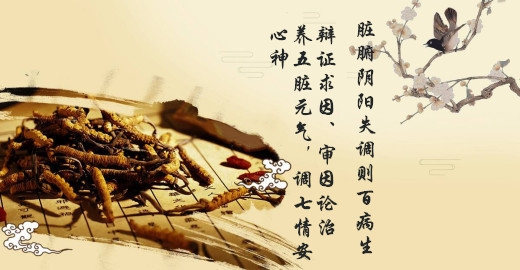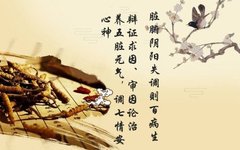

Promoting Traditional Chinese Medicine, Everyone Can Self-Medicate


Traditional Chinese Medicine’s Eight Principles of Diagnosis: Exterior and Interior, Cold and Heat, Deficiency and Excess, Yin and Yang
Cold and heat may seem simple at first glance, but when faced with disease, one finds that cold and heat often intertwine and dynamically evolve, making it quite complex.
The Suwen: The Great Treatise on True Essentials states: “Treat cold with heat, and treat heat with cold,” indicating that the treatment methods for the two are exactly opposite. Therefore, the differentiation of cold and heat must be precise.
We combine the nature of cold and heat with the nature of Yin and Yang; cold corresponds to Yin, termed Yin Cold; heat corresponds to Yang, termed Yang Heat, resulting in four types of syndromes:
When Yin is excessive, it results in a cold syndrome, where this Yin is either an external cold pathogen or an internal cold pathogen. Excessive Yin indicates a Yin Excess Syndrome, also known as “Excess Yin Leads to Cold“;
When Yang is deficient, it also results in a cold syndrome, where this Yang is the body’s Yang Qi. Deficient Yang indicates a Yang Deficiency Syndrome, also known as “Yang Deficiency Leads to Internal Cold“;
When Yang is excessive, it results in a heat syndrome, where this Yang is either an external heat pathogen or an internal fire pathogen. Excessive Yang indicates a Yang Excess Syndrome, also known as “Excess Yang Leads to Heat“;
When Yin is deficient, it also results in a heat syndrome, where this Yin is the body’s Yin fluids. Deficient Yin indicates a Yin Deficiency Syndrome, also known as “Yin Deficiency Leads to Internal Heat“.
Thus, it is evident that cold and heat must be considered in conjunction with Yin and Yang, as well as deficiency and excess, for comprehensive differentiation. However, do not worry; once you understand all aspects of the Eight Principles of Diagnosis, you can simply combine them based on symptoms.
For example, if a person has stomach pain that is vague and prefers warmth and pressure, we can determine from the stomach area that it is an “interior syndrome”; from the preference for warmth, we can determine it is a “cold syndrome”; and from the vague pain and preference for pressure, we can determine it is a “deficiency syndrome”, combining these leads to a diagnosis of “Yang Deficiency with Interior Cold of the Stomach”. The treatment method would be to “warm the center and assist Yang”, using the formula “Li Zhong Wan” as a base. This is just a simple example to illustrate that mastering the various aspects of differentiation will not be too difficult.
Now, let’s take a closer look at the specifics of cold and heat syndromes:
Cold Syndrome
【Concept】Cold syndrome is a pathological condition characterized by cold nature. It can be caused by exposure to cold pathogens or by the body’s own Yang deficiency and excessive Yin.
【Clinical Manifestations】Common symptoms include: aversion to cold and preference for warmth, pale complexion, cold limbs curled up, lack of thirst with a bland mouth, clear and thin phlegm and nasal discharge, clear and long urine, loose stools, pale tongue with white and slippery coating, and a slow or tight pulse. (Among these, aversion to cold is only seen in exterior syndromes, while the others can be seen in both exterior and interior syndromes.)
Analysis and Understanding of the Above Content:
Insufficient Yang Qi or injury from external cold prevents the body from warming itself, resulting in cold limbs, curled posture, and pale complexion.
Excessive internal Yin leads to the retention of fluids, hence the lack of thirst.
Yang deficiency fails to transform fluids, resulting in clear and cold excretions such as phlegm, nasal discharge, and urine.
Cold pathogens injure the spleen, or prolonged spleen Yang deficiency leads to impaired transformation and results in loose stools.
Yang deficiency fails to transform, leading to the generation of internal cold and resulting in a pale tongue with a white and slippery coating. Weak Yang Qi fails to propel blood circulation, hence a slow pulse; cold constricts, causing the pulse to be tight.
Heat Syndrome
【Concept】Heat syndrome is a pathological condition characterized by heat nature. It can be caused by exposure to heat pathogens or by the body’s own Yin deficiency and excessive Yang.
【Clinical Manifestations】Common symptoms include: aversion to heat and preference for coolness, thirst with a preference for cold drinks, red face and eyes, restlessness, yellow and thick phlegm and nasal discharge, hemoptysis and epistaxis, short and red urine, dry and hard stools, red tongue with yellow and dry coating, and a rapid pulse.
Analysis and Understanding of the Above Content:
Excessive Yang heat leads to aversion to heat and preference for coolness.
Fire heat injures Yin, depleting fluids, hence the thirst for cold drinks.
Fire rises, causing a red face and eyes.
Heat disturbs the mind, leading to restlessness.
Fluids are boiled down by Yang heat, resulting in yellow and thick secretions.
Fire heat injures blood vessels, causing hemoptysis and epistaxis.
Intestinal heat depletes fluids, leading to constipation.
A red tongue with yellow coating indicates heat syndrome, while a dry tongue with little fluid indicates Yin injury; excessive Yang heat accelerates blood flow, hence the rapid pulse.
Through the above comparative analysis, we summarize cold syndrome as: Cold, White (pale face, pale tongue), Moist (lack of thirst, clear excretions), Static (curled posture); heat syndrome as: Heat, Red (red face, red tongue), Dry (thirsty), Thick (murky excretions), Active (restlessness).
Note, do not equate the cold and heat here with the physical concepts of cold and heat; in this context, cold and heat refer to a set of syndromes and phenomena, not merely temperature.
Although cold and heat syndromes are fundamentally different, they are interconnected; they can appear simultaneously in the same patient, manifesting as mixed cold and heat symptoms, and can also transform into each other under certain conditions, leading to cold transforming into heat and heat transforming into cold. During the progression of a disease, especially in critical stages, there may also be phenomena of false cold or false heat.
Regarding mixed cold and heat:
One common example is the “upper heat and lower cold” syndrome, which is a very common manifestation of mixed cold and heat. The mechanisms behind upper heat and lower cold are varied, and I will write a separate article to analyze them later.
Symptoms of upper heat and lower cold include: the upper body is sensitive to heat, often experiencing heat-related issues such as oral ulcers, chronic pharyngitis, and acne that do not heal, while the lower body, starting from the waist down, is sensitive to cold, experiencing cold pain in the lower abdomen, cold pain in the waist and legs, and cold pain in the knees. In such cases, it is essential to differentiate and treat based on the underlying cause, such as whether it is kidney Yang deficiency, kidney Yin deficiency, or obstruction in the middle burner.
Of course, mixed cold and heat can also manifest as “upper cold and lower heat”, “exterior cold and interior heat”, “interior cold and exterior heat”, etc. There is no need to list them all; just match them to the patient’s condition. The key is to distinguish the relative amounts of cold and heat.When cold is predominant and heat is less, treatment should primarily address the cold while also considering the heat syndrome; when heat is predominant and cold is less, treatment should primarily address the heat while also considering the cold syndrome.
Regarding the transformation of cold and heat:
First Situation: Cold Syndrome Transforming into Heat Syndrome: This is a very common transformation pattern, often seen in external pathogenic diseases. For example, when exposed to cold pathogens, the initial presentation is an exterior cold syndrome, characterized by aversion to cold, fever, no sweating, white coating, and a floating tight pulse. As the disease progresses, the cold pathogen enters the interior and transforms into heat, with aversion to cold symptoms subsiding, followed by high fever, irritability, and thirst, yellow coating, and rapid pulse appearing, indicating a transformation from exterior cold to interior heat.
This transformation can occur for several reasons: firstly, missing the optimal time to expel the cold pathogen, while the body’s righteous Qi is still strong, allowing the cold pathogen to enter the interior and clash with the Yang Qi, leading to stagnation and transformation into heat. It can also occur due to improper treatment, such as excessive use of warming and drying herbs, which promotes the transformation of the pathogenic heat.
Second Situation: Heat Syndrome Transforming into Cold Syndrome: This is relatively rare and usually occurs due to excessive pathogenic heat or deficiency of the righteous Qi, where the body cannot withstand the pathogen, leading to functional decline; it can also occur due to misdiagnosis or improper treatment that damages Yang Qi.
This transformation can be gradual or rapid. For example, chronic dysentery due to heat can lead to Yang Qi depletion, transforming into a cold dysentery, which is a gradual transformation process; whereas in a high fever patient, due to excessive sweating, Yang Qi is lost through sweat, or excessive vomiting and diarrhea can lead to a sudden drop in body temperature, cold limbs, pale complexion, and a weak pulse, indicating a rapid transformation process (loss of Yang).
Regarding the authenticity of cold and heat:
When cold or heat syndrome develops to an extreme, there may sometimes be false manifestations that are opposite to the essence of the disease, known as true cold with false heat and true heat with false cold. These false manifestations are often seen in critical stages of the disease, and if not carefully observed, can lead to life-threatening consequences. For TCM enthusiasts, although there is little opportunity to encounter this, it is still necessary to have some understanding.
1. True Cold with False Heat: This is a condition where true cold exists internally, but false heat is observed externally. The mechanism arises from excessive internal cold obstructing Yang externally, hence also known as “Excessive Yin Obstructing Yang”.
Its manifestations include: body heat, floating red complexion, thirst, and a large pulse that seems to indicate heat syndrome, but the patient, despite appearing hot, prefers to be covered, desires hot drinks but can only drink a little, and the red complexion appears intermittently, not like the full redness of true heat, and the pulse is large but weak upon palpation. Additionally, cold limbs, clear diarrhea, and clear long urine may also be present. Therefore, the heat manifestation is false, while the essence of the disease is Yang deficiency with excessive cold.
2. True Heat with False Cold: This is a condition where true heat exists internally, but false cold is observed externally. The mechanism arises from excessive internal heat, with Yang Qi stagnating internally and rejecting Yin externally, hence also known as “Excessive Yang Obstructing Yin”.
Its manifestations include: cold hands and feet, a deep pulse, which seems to indicate cold syndrome, but the limbs are cold while the body is hot, showing aversion to heat rather than cold, with a deep and rapid pulse that is strong, along with thirst and preference for cold drinks, dry throat, bad breath, delirium, short and red urine, dry and hard stools, or heat dysentery with heavy sensation. In this case, the coldness of the hands and feet is a false cold phenomenon, while the internal heat is the essence of the disease.
The appearance of false manifestations often occurs in the limbs, skin, and complexion, while the internal manifestations of organs, Qi, blood, and fluids often reflect the true essence of the disease. Therefore, when differentiating, one should primarily rely on internal syndromes, tongue appearance, and pulse condition.
False manifestations are indeed different from true manifestations; for example, the false heat appearance of a red face is a pale complexion with only a slight red hue on the cheeks, appearing intermittently, while true heat presents as a fully flushed face; false cold often manifests as cold limbs, while the chest and abdomen are hot to the touch, or the whole body is cold but the patient does not want to be covered, while true cold presents as a curled posture desiring warmth.
Experienced TCM practitioners may use two cups of water to test the authenticity of cold and heat: one cup of hot water and one cup of cold water, allowing the patient to choose. The cup the patient instinctively reaches for reveals the truth of their condition; for instance, a person with true cold and false heat may appear to have heat symptoms but will prefer the hot water.
Distinguishing cold and heat will run through our entire process of differentiation for all diseases and will determine two completely different directions for treatment. If misused, the heat will become hotter, and the cold will become colder, leading to serious consequences, so caution is essential!
 Click the blue text to view other collections:
Click the blue text to view other collections:
Classic Formulas and the Use of Patent Medicines:Classic Formulas
Simple Formulas for Treatment and Health Preservation:Simple Formulas
External Treatment Methods: Treating Without Medication:External Treatment Methods
Understanding Common Diseases with TCM Thinking:Common Diseases
Read Good Articles to Learn TCM Easily:Read Good Articles
Learn Hand Diagnosis to Understand Health Trends:Learn Hand Diagnosis
Learn Tongue Diagnosis to Observe Health Status:Learn Tongue Diagnosis
Learn Differentiation for Targeted Treatment:Learn Differentiation
 If you like this article,
If you like this article,
Please like and share, thank you for your support!
Follow our public account and set it as a star,
to receive updates on new articles!

Click the card below to follow me

